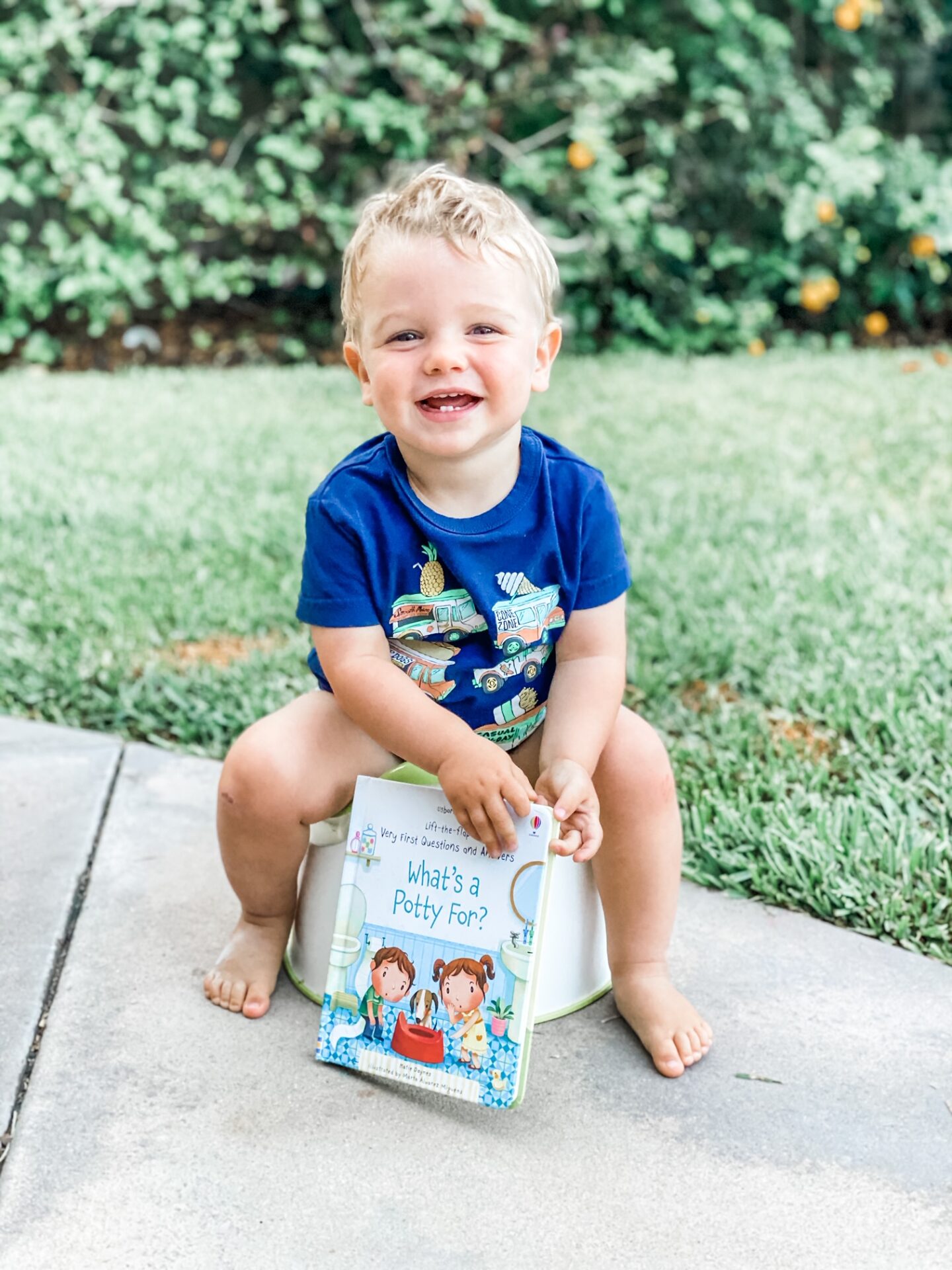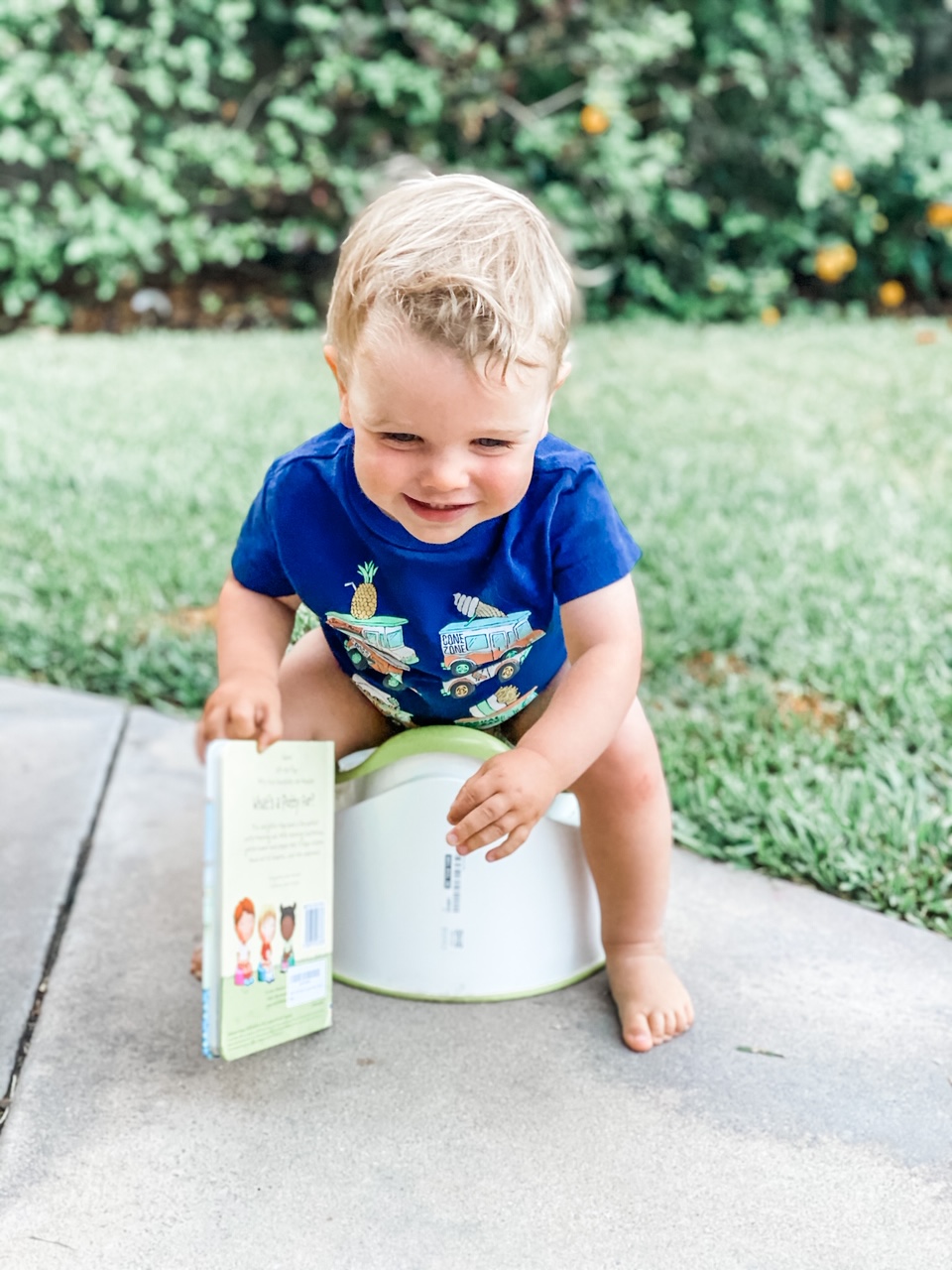I hate diapers. Almost as much as I hate the diaper genie. (It’s designed to be not gross, and it is still. so. gross.) Since my husband and I have both started working from home, every suspiciously stinky diaper has turned into a VERY competitive game of “YOU’RE IT!” I have even been known to run into the office, drop the poop-covered toddler at my husband’s feet, and run out again.
I know potty training also gets a bad rap, but I would much rather stay in for 3 days with a naked toddler than ever have to clean poop out of the 1 million crevices in my child’s tooshie, ever. again.
In the Montessori world, potty training starts super early, with something called “toilet awareness.” When I first heard this term, I was in a parent-teacher conference and had to choke back a giggle, as I imagined my daughter and her baby friends standing around a potty, suddenly in awe of its existence.
However, looking back on it now, I have to say that the system really works. My daughter was a breeze to potty train and, even before she was out of diapers, the strategies we used for changing her diaper, and talking about changing her diaper, made it a much less painful process than I know it was for some of my friends. (Again, I credit her school for this more than myself.)

We are currently in the “toilet awareness” phase with Max and, due to Covid-related school closures, are trucking along without the help of his truly angelic teachers. While I am not a Montessori teacher myself, I have been blessed to have worked with, learned from, and become close friends with, the experts. Below is an outline of the “toilet awareness” system I learned from them, and then tweaked to fit the reality of our life.
Supplies:
Before you start, make sure you have the following supplies. In our old house, the bathroom was tiny, so we set most of this up in Margot’s room. In our current house, we have everything except the bench set up in the bathroom. It doesn’t really matter where everything is, as long as the location stays pretty consistent.
- A training potty. We use the Baby Bjorn Smart Potty at home, and the OXO Tot Potty for on-the-go. The Baby Bjorn is a little more stable, but the OXO folds up and can be used in the car, at the park, etc. (I have always been tempted to buy one of the kid-sized “potty seats” that can be placed on top of our regular toilet. However, toddlers can’t use on their own, so it doesn’t foster the same type of independence as one of the aforementioned types would.)
- A small hamper for your child to throw his/her dirty clothes into after using the toilet. We used one similar to this. It’s important to pick something low enough that your child can reach the top by him/herself, but also plastic. Because, poop.
- A bench for your child to sit on after using the toilet. We used this step stool as a “bench” since it was small enough to fit into our bathroom. The child is supposed to use this time/space to practice putting his or her clothes back on. I also used it as a place where Margot knew she should go while I cleaned up and sanitized the toilet. It was somewhat difficult to teach Margot to sit and wait, and she definitely didn’t always do it, but I think it is an important component of teaching kids patience, and making sure they understand the work you put into cleaning up after them.
- A basket of books–preferably toilet related. You may want to read to your child while they sit on the potty in order to encourage them to stay there. We love this one, this one, and this one.
- Margot’s teachers requested that we set up a small hand-washing station, but our bathroom was tiny, and this seemed like more work than it was worth. All you need is a low table with a bowl, pitcher of water, soap and a towel, but we opted for using this learning tower to have her wash her hands at the kitchen sink instead.
Optional:
- We installed this Jonti Craft Infant Coordination Mirror and Bar in Margot’s room when she was a baby. She used the mirror during tummy time as an infant, and then used the bar a LOT when she was old enough to practice pulling herself up to standing. When we transitioned to stand-up diapering, we used this bar for diaper changes. It’s expensive, but Margot and Max both still use it (Margot for “ballet” and Max for diaper changes and giggling at himself).
Clothing:
Once Margot and Max reached 11 or 12 months old, we stopped using onesies, and moved exclusively to t-shirts and shorts. In order for kids to start participating in diaper changes and toilet awareness, they have to be able to pull their pants up and down on their own. I put Margot in dresses sometimes, but these also get tricky, as she couldn’t always hold them up and out of the toilet on her own. I buy almost all of my baby and toddler clothes from Target and Old Navy.
The Process:
When To Start:
I have read that toilet awareness can start around 12 months, but Max and Margot actually both started earlier. I think that kids are probably ready when they are beginning to participate in other “tasks” around the house (such as pulling laundry out of the basket while you are folding, or watching closely as you put cups and bowls from the dishwasher into the cabinet). When babies/toddlers start paying attention to these processes, they might be able to understand the association between their bodily fluids and the toilet. They should also, obviously, be able to sit on the potty without assistance.
What To Do:
Whenever your child has a dirty diaper, stand them up, either at a bar, or by the side of the tub. Remove the diaper and wipe them while they are standing. This will take some getting used to, but both of my kids actually preferred this to laying down on the changing table.
Margot’s teachers also told us to talk about feelings of “wetness” and “dryness” in non-judgmental way. This is really hard, and I mess it up a lot. Some phrases I try to use before the diaper change are, “you’re diaper is full,” or “you probably feel wet.” When we’re done, I try to narrate how we’re “all dry now” and “ready to play again.” With Margot, my first impulse is still to say, “oh no, an accident,” since my brain automatically goes to the inconvenience of cleaning it up but, you know, it’s hard not to be the center of our own universe.
After changing and wiping, have the child sit, naked, on the potty. You want to try to get them to stay there for a few minutes. You can sing to them, read a book together, make funny faces–whatever gets them to stay seated.
Over time (if you do this process pretty regularly) your child will start to associate diaper changes, as well as poop and pee, with this process of sitting on the potty. (Basically, they’ll think to themselves: “I pee, and then sit on the potty. Those two things go together!”)
Eventually, your child will pee (or poop!) on the potty. When this happens you GO OVER THE TOP BANANAS. Sing your praises of them. Shout it to the rooftops. Make them feel like a real champ. The more you pump them up, the more likely they are to do it again. We were told not to use rewards, as this can be a hard habit to break.
Max is 15 months old and he is now at the point where he runs to the potty when he needs a diaper change. He still only pees in the potty once in a blue moon, but he definitely knows that it has something to do with peeing and, most importantly, he enjoys sitting on it.

When To Move To “Potty Training”
Everyone that I have talked to has a different opinion on how to know when to start moving from “toilet awareness” to full blown potty training, but I think it’s important to look to your child first. We knew Margot was ready because she started going to the toilet on her own, and actually peeing in it about 50% of the time. After she did this for a few days in a row, we blocked off our weekend, and did the three-day potty training method. It was pretty similar to what is explained here, but I will write a more in-depth post on it when we get there with Max.
Some people say that kids are ready when they start pulling on their diaper, but Max has been doing this for MONTHS, and he is certainly not ready yet. I think it’s also really important to read how your kid reacts to the process and, if they started getting super wigged out, take a break and try again later. The last thing you want is for your kid to develop negative associations with the toilet.
Thanks for reading & wishing you HAPPY adventures in toilet training!
Montessori Toilet Awareness Books (Click to Buy):


My Favorite Potty Books! (Click to Buy):



